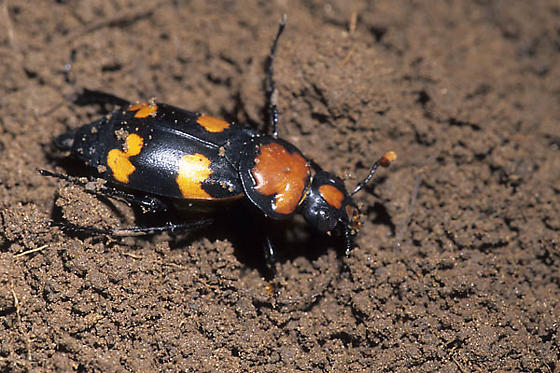American burying beetle
(Nicrophorus americanus)

Description
Nicrophorus americanus, also known as the American burying beetle or giant carrion beetle, is a critically endangered species of beetle endemic to North America. It belongs to the order Coleoptera and the family Silphidae. The carrion beetle in North America is carnivorous, feeds on carrion and requires carrion to breed. It is also a member of one of the few genera of beetle to exhibit parental care. The decline of the American burying beetle has been attributed to habitat loss, alteration, and degradation, and they now occur in less than 10% of their historic range. N. americanus adults are between 25 and 45 mm long and can be identified by their striking, distinctive coloring. The body is shiny black, and on each elytron (wing cover) are two scalloped, orange-red markings. Most distinctively, there is an orange-red marking on the pronotum, which distinguishes the species from all other North American Nicrophorus. The front of the head has two orange markings, one on the frons and a smaller one on the clypeus, the sclerite just above the mouthparts. The orange mark on the clypeus is smaller and more triangular in females than in males. The labrum has dense orange setae on the distal edge, and the antennal club is mostly orange. The adult is nocturnal and a strong flier, moving as far as a kilometer in one night. Historical records show that this beetle once lived in 35 states and the District of Columbia in the United States, and the provinces of Ontario and Quebec in Canada. Currently, natural populations are known to occur in only ten states: Rhode Island (Block Island), Oklahoma, Arkansas, Texas, Kansas, South Dakota, and Nebraska. They have also been reintroduced to Ohio, Massachusetts, and Missouri. During the winter months when temperatures are below 15 °C (60 °F) N. americanus adults bury themselves in the soil to overwinter. When temperatures are above 15 °C (60 °F) they emerge from the soil and begin the mating and reproduction process. Burying beetles are unusual in that both the male and female take part in raising the young. Male burying beetles often locate carcasses first and then attract a mate. Beetles often fight over the carcass, with usually the largest male and female individuals winning. The victors bury the carcass, the pair mates, and the female lays her eggs in an adjacent tunnel.
Taxonomic tree:







